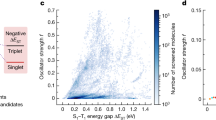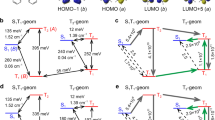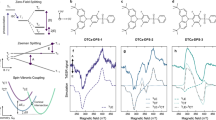Abstract
IT is commonly assumed that the emission spectrum of the delayed fluorescence of an organic material is identical with that of the prompt fluorescence, because the two spectra arise from a radiative transition between the same two electronic levels, although the origin of the excitation differs. Recently a difference has been reported between the prompt and delayed fluorescence spectra of fluorescein in boric acid1,2 and of trypaflavin in polymethyl methacrylate3. Three possible causes of the phenomenon have been suggested2: (1) the possible existence of two metastable (triplet) levels, T1 and T2, in some molecules; (2) intermolecular migration of the triplet excitation energy; and (3) a possible difference in the transition probability distribution for prompt and delayed fluorescence.
This is a preview of subscription content, access via your institution
Access options
Subscribe to this journal
Receive 51 print issues and online access
$199.00 per year
only $3.90 per issue
Buy this article
- Purchase on Springer Link
- Instant access to full article PDF
Prices may be subject to local taxes which are calculated during checkout
Similar content being viewed by others
References
Pohoski, R., Bull. Acad. Polon. Sci. Ser. Sci. Math. Astron. Phys., 10, 505 (1962).
Grzywacz, J., and Pohoski, R., Z. Naturfarsch., 19 a, 440 (1964).
Kawski, A., Z. Naturforsch., 20 a, 1734 (1965).
Author information
Authors and Affiliations
Rights and permissions
About this article
Cite this article
GRZYWACZ, J. Difference between Prompt and Delayed Fluorescence Spectra. Nature 213, 385–386 (1967). https://doi.org/10.1038/213385a0
Received:
Issue Date:
DOI: https://doi.org/10.1038/213385a0
This article is cited by
-
A gelable pure organic luminogen with fluorescence-phosphorescence dual emission
Science China Chemistry (2017)
Comments
By submitting a comment you agree to abide by our Terms and Community Guidelines. If you find something abusive or that does not comply with our terms or guidelines please flag it as inappropriate.



